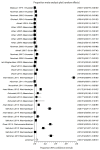Freshwater snails as the intermediate host of trematodes in Iran: a systematic review
- PMID: 30754962
- PMCID: PMC6446068
- DOI: 10.4178/epih.e2019001
Freshwater snails as the intermediate host of trematodes in Iran: a systematic review
Abstract
Freshwater snails, as the first intermediate hosts of trematodes, can cause health hazards in animals and humans. Recently, the World Health Organization has included Iran in a list of 6 countries known to have serious problems with fascioliasis. In addition, cercarial dermatitis is a job-related disease that is seen often in paddy workers, agricultural labourers, and fishermen in Iran, particularly in Mazandaran Province. Many studies have been conducted in Iran to survey larval trematodes in freshwater snails. However, to the best of our knowledge, no comprehensive data exist regarding infections in gastropods. Therefore, the aim of the present study was to estimate the types and prevalence of cercarial infections in snails in Iran. Electronic English-language and Persian-language databases were searched to identify 24 published articles reporting the prevalence of trematode infections in snails (9 species from 6 families) in various provinces of Iran. In total, 4.4% of gastropods were infected with the larval stages of trematodes. According to the studies reviewed in this meta-analysis' the highest infection prevalence was found in Radix auricularia (9.9%). Twelve larval species of trematodes were identified, and the highest prevalence of cercariae was found for Echinostomatidae cercariae (4.3%). Among the provinces explored, West Azerbaijan had the highest prevalence of infected snails (16.9%). The presence of trematodes in snails could pose a serious health problem in Iran. Thus, further studies are necessary to characterize these infections in other provinces.
Keywords: Iran; Meta-analysis; Prevalence; Snail; Trematodes.
Conflict of interest statement
The authors have no conflicts of interest to declare for this study.
Figures





Similar articles
-
Insights on foodborne zoonotic trematodes in freshwater snails in North and Central Vietnam.Parasitol Res. 2021 Mar;120(3):949-962. doi: 10.1007/s00436-020-07027-1. Epub 2021 Jan 10. Parasitol Res. 2021. PMID: 33426572
-
Epidemiology of cercarial stage of trematodes in freshwater snails from Chiang Mai province, Thailand.Asian Pac J Trop Biomed. 2013 Mar;3(3):237-43. doi: 10.1016/S2221-1691(13)60058-1. Asian Pac J Trop Biomed. 2013. PMID: 23620846 Free PMC article.
-
Freshwater Snail Diversity in Mae Lao Agricultural Basin (Chiang Rai, Thailand) with a Focus on Larval Trematode Infections.Korean J Parasitol. 2018 Jun;56(3):247-257. doi: 10.3347/kjp.2018.56.3.247. Epub 2018 Jun 30. Korean J Parasitol. 2018. PMID: 29996628 Free PMC article.
-
An overview of freshwater snails in Asia with main focus on Vietnam.Acta Trop. 2014 Dec;140:105-17. doi: 10.1016/j.actatropica.2014.08.005. Epub 2014 Aug 18. Acta Trop. 2014. PMID: 25149356 Review.
-
One hundred years of research on the natural infection of freshwater snails by trematode larvae in Europe.Parasitol Res. 2009 Aug;105(2):301-11. doi: 10.1007/s00436-009-1462-5. Epub 2009 May 13. Parasitol Res. 2009. PMID: 19437040 Review.
Cited by
-
Environmental determinants of distribution of freshwater snails and trematode infection in the Omo Gibe River Basin, southwest Ethiopia.Infect Dis Poverty. 2019 Nov 20;8(1):93. doi: 10.1186/s40249-019-0604-y. Infect Dis Poverty. 2019. PMID: 31744539 Free PMC article.
-
Association between human cercarial dermatitis (HCD) and the occurrence of Trichibilarizia in duck and snail in main wetlands from Mazandaran Province, northern Iran.Parasite Epidemiol Control. 2021 Mar 16;13:e00211. doi: 10.1016/j.parepi.2021.e00211. eCollection 2021 May. Parasite Epidemiol Control. 2021. PMID: 33898795 Free PMC article.
-
Study on the prevalence of trematode cercariae infection in freshwater snails in Manipur, India.J Parasit Dis. 2024 Dec;48(4):950-958. doi: 10.1007/s12639-024-01709-8. Epub 2024 Aug 27. J Parasit Dis. 2024. PMID: 39493483
-
Trematode Cercariae from Lymnaea gedrosiana in the Caspian Sea Littoral in Iran: a one health concern.Front Microbiol. 2023 Jul 14;14:1222599. doi: 10.3389/fmicb.2023.1222599. eCollection 2023. Front Microbiol. 2023. PMID: 37520358 Free PMC article.
-
Contamination of Vector Snails with the Larval Stages of Trematodes in Selected Areas in Northern Iran.Iran J Public Health. 2022 Jun;51(6):1400-1410. doi: 10.18502/ijph.v51i6.9697. Iran J Public Health. 2022. PMID: 36447972 Free PMC article.
References
-
- Yakhchali M, Ghobadi K. Survey of liver helminthes infection rate and economic loss in sheep in Urmia slaughterhouse. Sci-Res Iran Vet J. 2005;9:60–66. (Persian)
-
- Curtis LA. Larval trematode infections and spatial distributions of snails. Invertebr Biol. 2007;126:235–246.
-
- Skála V, Bulantová J, Walker AJ, Horák P. Insights into the development of Notocotylus attenuatus (Digenea: Notocotylidae) in Lymnaea stagnalis: from mother sporocyst to cercariae. Parasitol Int. 2014;63:94–99. - PubMed
-
- Doughty BL. Schistosomes and other trematodes. In: Baron S, editor. Medical microbiology. 4th ed. Galveston: University of Texas Medical Branch at Galveston; 1996. p. chapter 88.
-
- Ghobaditara M, Fakhar M, Karamian M, Sharif M. An overview on present situation of cercarial dermatitis: a neglected zoonotic disease in Iran and the world. J Mazandaran Univ Med Sci. 2015;24:446–460. (Persian)
Publication types
MeSH terms
Grants and funding
LinkOut - more resources
Full Text Sources
Research Materials

